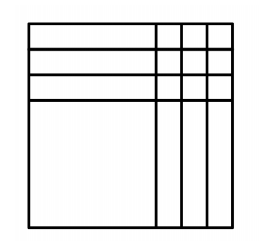Completing the Square and Area
1.
Optima has a quilt shop where she sells many colorful quilt blocks for people who want to make their own quilts. She has quilt designs that are made so that they can be sized to fit any bed. She bases her designs on quilt squares that can vary in size, so she calls the length of the side for the basic square x, and the area of the basic square is the function . In this way she can customize the designs by making bigger squares or smaller squares. If Optima adds 3 inches to the side of the square, what is the area of the square?
When Optima draws a pattern for the square in problem #1, it looks like this

2.
Use both the diagram and the equation, to explain why the area of the quilt block, is also equal to .
3.
Block with side length: x+2
4.
Block with side length: x+1
5. What patterns do you notice when you relate the diagrams to the two expressions for the area?
6.
a.
b.
c.
d.
7.
If is a perfect square, what is the relationship between b and c? How do you use b to find c, like in problem 6? Will this strategy work if is negative? Why or why not? Will the strategy work if is an odd number? What happens to if is odd?